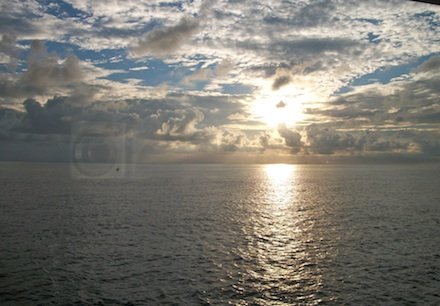
Fossil Fish Scales and Shell Bits (say that five times fast!)
Looking southeast out of my office window at 6 am, a beautiful sunrise over Costa Rica. You can see the reflection of my camera in the window…
Where are we now?
Off the western coast of Costa Rica, in the Pacific Ocean, Site U1413. Our coordinates are now 8°44’ North, 84°7’ West. Water depth: 540 meters (~1.22 mile). Air temperature is 28 °C (82 °F) and the water temperature staying steady at 33 °C (91 °F).
Scientists at Work
So far at this site, we have collected cores containing greenish-gray silty clay with a bunch of fine sand turbidites (from underwater “avalanches”), and many foraminifera. We also have found a few volcanic ash layers from ancient Costa Rican eruptions. A first look at the nannofossils and radiolarians puts these sediments at somewhere in the Upper Pleistocene age. Since we had many cores coming in today, I worked at the sample table with Yuzuru Yamamoto.

I’ll bet you are wondering how a geologist decides whether a sample is greenish-gray or grayish green, right? Well, if you have your handy-dandy Munsell Color Chart, which comes in many, many colors, you can match it up…it is almost like art class!

We have had great core recovery, and our target depth is 900 meters below sea floor (mbsf) here. As of this evening, they are bringing up cores from about 200 mbsf, and have run into some pretty solid rock along the way.
Some beautiful cores have been laid out on the sample table today! (Perhaps only to a geologist…) Lot’s of dark gray carbonaceous silty clays interspersed with light gray volcanic ash layers, pieces of brown wood-like substance, and small shell fragments. And, throw in a few fossil fish scales, as well!

One of the ways to tell if the sediments contain carbonates is to put a sample of the core into hydrochloric acid (HCl). If it contains carbonates, the acid solution will immediately begin to bubble, giving off carbon dioxide gas. This afternoon, when micropaleontologist Maria Sandoval Gutierrez placed a sediment sample into the HCl, not only did it bubble, but the solution also turned blue, leaving her to try to figure out what else was in that particular sediment.

Life on Board
Another mystery solved! Once again, I was out seeing what I could see around the ship when I saw two of the crewmen up at the bow leaning way out over the front.

Looking around from the side of the ship, I saw what they were helping with…Ship painting continues with a beautiful blue!

A nice rainbow appeared off the side of the ship, and Co-Chief Scientist Arito Sakaguchi photographed someone photographing the rainbow!

From the subduction zone, where coring is our business…
For more photos, see our Facebook page!